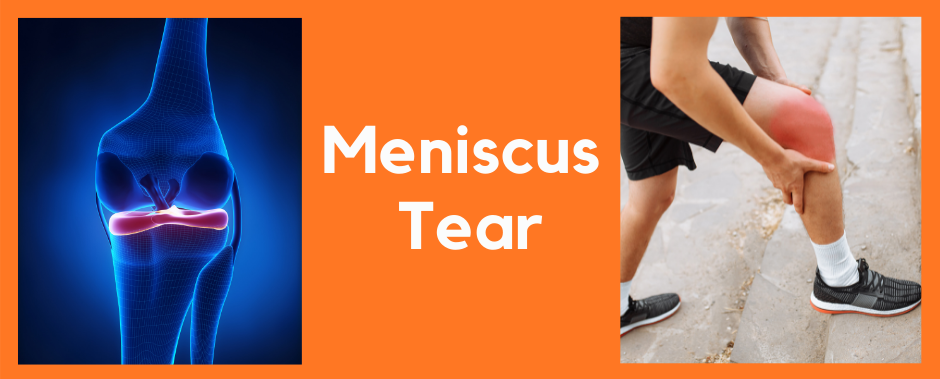
In each knee joint, you have two C-shaped pads called menisci (singular = meniscus) that sit between the ends of the femur (thigh bone) and tibia (shin bone), one on the inside of the knee joint and one on the outside (illustrated below).
 Your menisci have a vital role in helping you absorb the shock that goes through your knee during movement and activity. They help distribute the load safely through the joint, help stabilise the knee, and protect the other knee structures like the articular cartilage. This means they’re exposed to large forces – which, if too great, can result in a meniscal tear.
Your menisci have a vital role in helping you absorb the shock that goes through your knee during movement and activity. They help distribute the load safely through the joint, help stabilise the knee, and protect the other knee structures like the articular cartilage. This means they’re exposed to large forces – which, if too great, can result in a meniscal tear.
Picture: Bird’s eye view, looking down at the top of your shin bone
How is a meniscus injured?
Most often, meniscus injuries occur when the foot and leg are firmly planted on the ground, and the upper body and knee twist, forcefully tearing the meniscus. This is most common in children and young adults, often occurring during sports that have twisting or pivoting movements, rapid changes in direction and repetitive bending and straightening of the knee, like in basketball or netball.
In older adults, meniscal injuries are often gradual and a result of a longstanding degenerative process, as opposed to a defined event that tears the meniscus.
Other knee injuries can also subsequently tear the meniscus. The NZ Orthopaedic Association reported that when completing ACL reconstructions (a ligament found within the knee joint), approximately one-third of people also had significant meniscal tears that also required treatment.
How do I know if I’ve torn my meniscus?
If your tear occurs suddenly during exercise, you’ll likely feel a sudden sharp pain and a potential ‘popping sound’, followed by swelling, with your pain feeling worse when the knee is bent and straightened, or when you put weight on it. In the hours after the tear, you may start to feel stiffness and instability in the joint.
If you’re an older adult and your injury has been progressing and degenerating for some time, then you may start with just slight discomfort, dull ache, or niggle. This discomfort may come and go, but eventually will worsen and linger for longer, gradually causing knee instability and pain or discomfort when walking.
If you suspect you have torn your meniscus, it’s important to have it diagnosed professionally and immediately to confirm the diagnosis while ruling out other causes of knee pain like ligament tears, tendon strains and more. This is something that we can help with at Masterton Foot Clinic.
Meniscus tear treatment
It’s essential to have suspected meniscus tears professionally assessed, diagnosed and treated. Many structures with the knee and around the knee can cause knee pain, and depending on the cause, can require very different treatment. Having the wrong diagnosis may see you spending time and money treating knee pain without success, and your injury may worsen in the meantime.
The first step is to see your podiatrist. We can help rule out other causes of knee pain, refer you for imaging to confirm your diagnosis, and start you on a treatment plan with the goals of both relieving your pain and discomfort, and allowing the knee to heal and repair.
At Masterton Foot Clinic, we treat every person and every case of knee pain uniquely. Your treatment will vary based on how severe your tear is, where the tear is, how it has torn, and the blood supply in the area of the tear. While small tears can respond brilliantly in an area with good vascularisation (blood supply), larger tears in areas with poor blood flow may need additional measures and care. This will be determined by your ultrasound or MRI imaging and we’ll make the best treatment plan for you from there.
You can help manage your pain at home by using ice, anti-inflammatories and keeping your knee elevated to help reduce the swelling. Rest your knee as much as possible before you can make it in to see your podiatrist and get your treatment plan.
FAQs
What are the best strengthening and stretching exercises for a meniscus tear?
We recommend heel slides, hamstring curls, straight leg raises, mini squats, a standing hamstring stretch and a figure four stretch. See how to do these here.
How do I know if I’ve torn my medial or lateral meniscus?
The location of your tear may influence the pain you feel – whether it’s on the inside or outside of the knee joint. Medical imaging is generally the only way to be certain. With this said, the conservative treatment you can do at home does not change regardless of which side your tear is on. Your podiatrist may make slight adjustments in your professional treatment plan, such as the specific features of your orthotics.
I experience sudden sharp knee pain during skiing. Could this be a meniscus tear?
We see many snow sport-related meniscus tears, alongside sports including basketball, soccer and rugby. The only way to know for certain, however, is through an assessment. During your appointment with our podiatrists we’ll rule out other causes of your knee pain and confirm the nature of your injury.
Does ACC cover treating a torn meniscus?
If your injury was sustained as a result of an accident, then you may be eligible for ACC. We will fill your paperwork and submit a claim, it is up to ACC whether or not you are covered.
